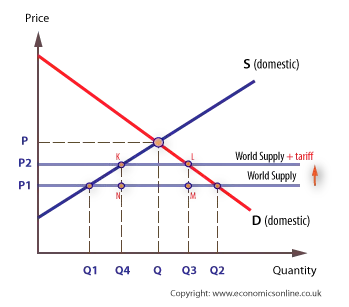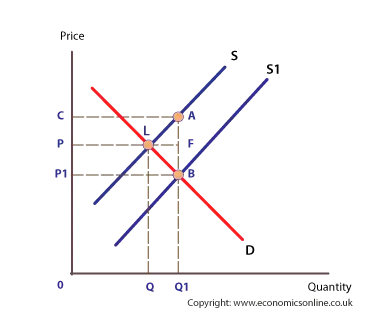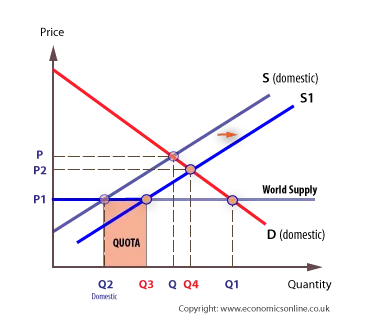
Ch 24 - Free Trade and Protectionism
Free trade: international trade (imports and exports) without government restrictions
Trade of goods and services without trade barriers
Protectionism:
Protection of domestic industries against foreign competition
Government restrictions are placed on the imports of foreign competitors (tariffs, quotas and subsidies)
Arguments for protectionism:
Protecting domestic employment
Protecting the economy from low cost labour
Protecting the economy from low cost labour
Protecting an infant (sunrise) industry
To conclude:
Protectionism raises prices to the consumers and producers of the input
Less choice for consumers
Competition would diminish and domestic firms would become inefficient
Reduced economic growth
Comparative advantage is distorted leading to inefficient use of world resources
Types of protectionism:
Tariff : a tax that is charged on an imported good. Any tax will cause suppliers to supply less

If wheat (example) is not purchased there is a deadweight loss of welfare
There is a deadweight loss of welfare
There is inefficiency of domestic products and a loss of world efficiency
Subsidy: an amount of money paid by the government to a form per unit of output

Government is giving the subsidy to the fir to make it more competitive
Domestic supply curve will shift downward reducing the price
Consumers are indirectly affected by the government’s use of tax revenues to find the subsidy
Could lead to higher taxes and is an opportunity cost, governments could spend taxes on other things
Quotas: physical limit on the number of value of goods that can be imported to a country

Excess demand of Q3Q2, prices begin to rise
As price rises, imports are not allowed to supply more
Domestic products begin to enter the market attracted by the high price of wheat
Voluntary export restraints:
Agreements between exporting and importing countries in which the exporting country agrees to limit the quality of exports of a specific good below a certain level
Administrative barriers:
When goods are imported there are always administrative processes
Health, safety, and environmental standards:
When restrictions are put on the type of goods that can sold in the domestic market
Embargoes: complete ban on imports
National embargoes: marketing campaigns to encourage people to buy domestic goods
Ch 24 - Free Trade and Protectionism
Free trade: international trade (imports and exports) without government restrictions
Trade of goods and services without trade barriers
Protectionism:
Protection of domestic industries against foreign competition
Government restrictions are placed on the imports of foreign competitors (tariffs, quotas and subsidies)
Arguments for protectionism:
Protecting domestic employment
Protecting the economy from low cost labour
Protecting the economy from low cost labour
Protecting an infant (sunrise) industry
To conclude:
Protectionism raises prices to the consumers and producers of the input
Less choice for consumers
Competition would diminish and domestic firms would become inefficient
Reduced economic growth
Comparative advantage is distorted leading to inefficient use of world resources
Types of protectionism:
Tariff : a tax that is charged on an imported good. Any tax will cause suppliers to supply less

If wheat (example) is not purchased there is a deadweight loss of welfare
There is a deadweight loss of welfare
There is inefficiency of domestic products and a loss of world efficiency
Subsidy: an amount of money paid by the government to a form per unit of output

Government is giving the subsidy to the fir to make it more competitive
Domestic supply curve will shift downward reducing the price
Consumers are indirectly affected by the government’s use of tax revenues to find the subsidy
Could lead to higher taxes and is an opportunity cost, governments could spend taxes on other things
Quotas: physical limit on the number of value of goods that can be imported to a country

Excess demand of Q3Q2, prices begin to rise
As price rises, imports are not allowed to supply more
Domestic products begin to enter the market attracted by the high price of wheat
Voluntary export restraints:
Agreements between exporting and importing countries in which the exporting country agrees to limit the quality of exports of a specific good below a certain level
Administrative barriers:
When goods are imported there are always administrative processes
Health, safety, and environmental standards:
When restrictions are put on the type of goods that can sold in the domestic market
Embargoes: complete ban on imports
National embargoes: marketing campaigns to encourage people to buy domestic goods
 Knowt
Knowt
